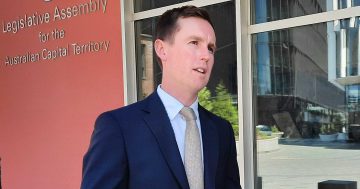
The community housing development in Chapman proceeded before the outcome of an ACAT appeal was released. Photo: File.
Development is always going to be a controversial topic in Canberra.
We love our planned city, and each new building or infrastructure project becomes a site for debate (and usually rightly so). But when the development in question is a community housing project, the terms of the debate become more fraught.
Suddenly, anyone opposed to the project is a ‘NIMBY’ (Not In My Backyard, for those not in the know), and the government is the progressive saviour of the disadvantaged.
Now, in the case of some opposition to community housing developments, this is, in fact, the case. When Nicholls residents protested the building of community housing in 2015, their concerns were that the development would bring a ‘negative impact’ on the community (which is code for ‘no poor people allowed here’).
Residents were concerned about the safety of their children at the primary school near the proposed site, which is clearly based on an attitude of prejudice against those in our community who access community housing for a wide range of reasons.
And the more recent resident opposition to plans for a community housing project in Ainslie also reeks of NIMBY-ism, given the argument against the building of 10 units specifically for use by women at risk of homelessness is that the green space (in a suburb with ample green space) is too prized by the community to be lost, as is an old preschool building that is used by the community. This is despite the fact that YWCA Canberra, the organisation that will be developing the site, has assured residents that no part of the public park will, in fact, be built on.
But in other cases, it does seem like the Government uses the cry of ‘NIMBY’ to avoid addressing genuine development concerns by informed residents.
A good example of this is back in 2017 in Chapman, where a community housing development pushed ahead before the outcome of an ACAT appeal against the project by residents was released. In this case, residents were rightfully concerned about the bushfire threat to the development site and the distance from local amenities, even proposing alternative sites in the suburb.
And in the current case of the Common Ground development planned for Block 25 Section 72 in Dickson, residents represented by the North Canberra Community Council are concerned about the flood risk to the site, the potential contamination by asbestos and, more importantly, the lack of an integrated development plan for Section 72 as a whole.
The issue here is no comprehensive planning from the government for the site as a whole, and the potential for the site to become haphazard with poor infrastructure if piecemeal projects like this forge ahead without further interrogation.
I’m no planning expert, but it doesn’t take one to see that development across Canberra, whether community housing or not, is unfolding rapidly and often without apparent thought for the flow-on effects to public transport, road use, and other amenities in the area for existing residents.
Turning the passion and dedication of residents with genuine concerns about a development project into an ideological stoush about progressive values and supporting the disadvantaged is disingenuous on the government’s part, and should be called out.
Just as not all community housing projects should be protested by local residents wanting to protect the reputation of their suburbs, not all residents opposing community housing are doing so because they don’t want poor people in their backyard.
Zoya Patel is a writer and editor based in the ACT, and was the 2015 ACT Young Woman of the Year.





















